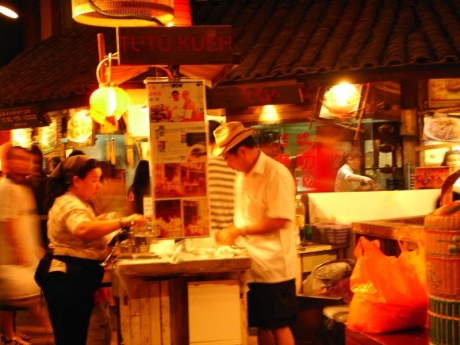Why Singapore Is Food-Obsessed And More
Writer Cheryl Lu-Lien Tan to traveled her birthplace, Singapore, and spent a year there learning to cook the food of her childhood, which she writes about in her memoir A Tiger in the Kitchen. The Daily Meal asked her for her expert tips on where and what you've got to eat in Singapore.
Why do people say that Singapore is "food-obsessed"?
Singaporeans always say we don't eat to live, we live to eat. The food in Singapore is amazing — diverse and complex and, unfortunately, often difficult to replicate in home kitchens. It's also hard to find decent versions of it outside of Southeast Asia so for those of us who live far from Singapore, it definitely becomes an obsession.
What is Singaporean cuisine, really?
It's a fusion cuisine that began in the early 19th century when British, Indian, Malay, and Chinese traders began flocking to Singapore. Over time, the flavors of the different cultures meshed in the kitchen, giving rise to unique dishes that are hard to find in other parts of the world. Chili crab, for example, combines the abundance of local seafood with spicy flavors. In Singapore, you'll find Chinese, Indian, Malay, and even Eurasian curries side by side, each slightly different because of its origins. A popular Eurasian dish around Christmastime is debal, or Devil's Curry, which turns Christmas leftovers such as ham, potatoes, and turkey into a Southeast Asian curry.
With so many cultural influences, did you find ingredients or techniques that are indigenous to Singapore?
The ingredient that you tend to see in a lot of dishes — both sweet and savory — is the tropical pandan leaf, which is similar to vanilla in scent and flavor but a little more complex. Cooks will often knot up these long leaves and toss them into soups or jams for a slight vanilla flavoring. One of my aunts knots them up and puts them in boiling pots of water that she's using to boil pork dumplings.
Click here for Cheryl's Pineapple Tarts Recipe.
What dishes should a first-time diner at a Singaporean restaurant in, say, New York try?
Roti canai — crisp Indian flat breads that you dip in curry — is a must. My favorites that I actually do see on New York menus include beef rendang, a coconutty curry where the beef is incredibly tender, and kangkung belacan, which is Chinese water spinach stir fried in a spicy fermented shrimp sauce.
What are three must-have food experiences in Singapore?
A hawker center is a must — it is basically an outdoor food court that features vendors selling a range of dishes: Malay curries, Chinese porridge, turtle soup, Indian satay, and even Western dishes such as fries and pork chops. Each vendor tends to sell just one kind of dish, and some of them become so famous for that one dish that Singaporeans travel from all parts of the country in order to eat it. Food at hawker centers is incredibly inexpensive: most dishes cost about U.S. $2.
I would also try to go to an Indian restaurant that does the "banana leaf" experience, where they give you a large banana leaf, spoon and fork and then waiters come around with tubs of rice and various curries and scoops whatever you want onto the leaf. My favorite place for this kind of dining is Samy's Curry — they do a terrific mutton mysore there (ask for the "dry mutton") and fish and potato patties.
Singapore has a lot of terrific places to eat by the water — East Coast Lagoon Food Centre is an excellent one. There are a few great satay stalls there, as well as places that sell good versions of won ton noodles and sugarcane juice. It's inexpensive and you have a lovely view of the beach as you eat.
Who are the most revered chefs or cooks in Singapore?
The most beloved cooks tend to be hawkers — one of my favorites is the guy who has been frying noodles at Hill Street Char Kway Teow for decades, for example. But on the high end, there are a few chefs/restaurateurs who have been highly praised recently — Ignatius Chan, who does inventive fusion dishes at Iggy's restaurant, has become a go-to guy for politicians and high-powered businesspeople.
Willin Low, chef at the "Mod Sin" (Modern Singaporean) restaurant Wild Rocket, has been recently noted in the New York Times and Food & Wine magazine for his dishes that combine old-school Singapore flavors with Italian or Western touches. One of my favorite dishes at Wild Rocket is a baked, cheesy cannelloni that's stuffed with Chinese-style pork that's been braised in soy sauce, star anise and cinnamon. (Photo courtesy of flickr/yummiec00kies)
Click here for Tracing Family Heritage Through Food.

